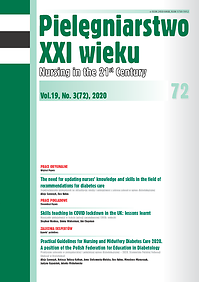Nursing care of a child with type 1 diabetes mellitus – a nursing process using the International Classification of Nursing Practice ICNP®
DOI:
https://doi.org/10.2478/pielxxiw-2020-0029Keywords:
child, nursing process, diabetes, International Classification of Nursing PracticeAbstract
NURSING CARE OF A CHILD WITH TYPE 1 DIABETES MELLITUS – A NURSING PROCESS USING THE INTERNATIONAL CLASSIFICATION OF NURSING PRACTICE ICNP®
Introduction. Type 1 diabetes is the most common chronic childhood disease.
Aim. The aim of the study is to present the process of nursing a child with DMT1 and its family using the terminology from ICNPR.
Material and methods. The study is based on a case report and a literature review. The study was conducted in December 2019. A written consent of the child’s mother was obtained for the study.
Results and conclusions. Proper nursing care, intensive diabetes education and optimal treatment are essential to ensure the best quality of life while minimizing the risk of acute metabolic disorders and chronic complications. Using ICNPR terminology enables the creation of a detailed and holistic nursing process for a child with DMT1 and its family. Based on the information obtained, nursing diagnoses were formulated: dyspnea, nausea, hyperglycaemia, hypoglycaemia, lack of knowledge of illness, lack of knowledge of treatment regime, lack of knowledge of diet regime, overweight, anxiety, impaired socialization, risk of impaired parenting. The nursing interventions will help to achieve an appropriate standard of living as well as reduce the risk of acute metabolic disorders and chronic diabetes complications.
References
1. Rechenberg K, Whittemore R, Holland M, et al. General and diabetes-specifi c stress in adolescents with type 1 diabetes. Diabetes Res Clin Pract. 2017;130:1-8. DOI: 10.1016/j.diabres.2017.05.003.
2. Blair JC, McKay A, Ridyard C, et al. Continuous subcutaneous insulin infusion versus multiple daily injection regimens in children and young people at diagnosis of type 1 diabetes: pragmatic randomised controlled trial and economic evaluation, BMJ. 2019;365:1-12. DOI: 10.1136/bmj.l1226.
3. Rechenberg K, Grey H, Sadler L. Stress and Posttraumatic Stress in Mothers of Children With Type 1 Diabetes J Fam Nurs. 2017;23(2):201-225. DOI: 10.1177/107484071668754.
4. Rabelo-Silva ER, Dantas Cavalcanti AC, Goulart Caldas MCR, et al. Advanced Nursing Process quality: Comparing the International Classification for Nursing Practice (ICNP) with the NANDA-International (NANDA-I) and Nursing Interventions Classification (NIC), J Clin Nurs. 2016;26:379–387. DOI: 10.1111/jocn.13387.
5. https://www.icn.ch/what-we-doprojectsehealth-icnptm/about-icnp, dostęp: 12.07.2020
6. Ślusarska B. Implementacje praktyczne wybranych klasyfi kacji diagnoz i interwencji pielęgniarskich dla pielęgniarstwa polskiego Zdrowie Publiczne i Zarządzanie. 2016;14(1):11–22. DOI: 10.4467/20842627OZ.16.002.5564.
7. https://www.icn.ch/what-we-do/projects/ehealth/icnp-browser, dostęp: 12.07.2020
8. Petersmann A, Müller-Wieland D, Müller UA, et al. Defi nition, Classifi cation and Diagnosis of Diabetes Mellitus. Exp Clin Endocrinol Diabetes. 2019;127:S1-S7. DOI: 10.1055/a-1018-9078
9. Polskie Towarzystwo Diabetologiczne: Zalecenia kliniczne dotyczące postępowania u chorych na cukrzycę 2020. Diabetologia Praktyczna. 2020;6,1:1–106. DOI: 10.5603/DK.2020.0001
10. https://diabetesatlas.org/en/sections/worldwide-toll-of-diabetes.html, dostęp: 09.08.2020
11. Orzan A, Novac C, Mihu M, et al. Type 1 diabetes and thyroid autoimmunity in children. Maedica (Buchar). 2016;11(4):308-312.
12. Elsamahy MH, Elhenawy YI, Altayeb N. Long-term prognosis of type 1 diabetes in relation to the clinical characteristics at the onset of diabetes. Egyptian Pediatric Association Gazette. 2017;65(3):90–94. DOI:10.1016/j .epag.2017.04.004
13. Jarosz-Chobot P, Polańska J, Szadkowska A, et al. Rapid increase in the incidence of type 1 diabetes in Polish children from 1989 to 2004, and predictions for 2010 to 2025. Diabetologia. 2011;54(3):508–515. DOI:10.1007/s00125-010-1993-4
14. Chobot A, Polanska J, Brandt A, et al. Updated 24‐year trend of Type 1 diabetes incidence in children in Poland reveals a sinusoidal pattern and sustained increase. Diabet Med. 2017;34(9):1252–1258. DOI:10.1111/dme.13345
15. Górska M. Obraz kliniczny cukrzycy typu 1. [w:] Sieradzki J, red. Cukrzyca. Gdańsk: Wyd. Via Medica; 2006, s. 312–318.
16. Derkacz M, Chmiel-Perzyńska I, Nowakowski A. Problemy hipoglikemii w cukrzycy. Curr. Prob. Psychiatry. 2011;12(4):569–574.
17. Hermanns N, Kulzer B, Kubiak T, et al. The eff ect of an education programme (HyPOS) to treat hypoglycaemia problems in patients with type 1 diabetes. Diabetes Metab. Res. Rev. 2007;23:528–538.
18. Mianowska B, Szadkowska A, Młynarski W. Hipoglikemia w przebiegu cukrzycy typu 1 u dzieci i młodzieży — charakterystyka, zapobieganie, leczenie. Stand. Med. Pediatr. 2010;7:426–433.
19. Tatoń J, Czech A. Spełniamy wyzwanie: Personalistyczna diabetologia w praktyce. Metodologiczny zarys personalistycznie ujętej edukacji terapeutycznej i psychospołecznej osób z cukrzycą - własne doświadczenia oparte na EBM. Med. Metab. 2011;XV(2):41–51.
20. Cradock S, Cranston C. Type 1 diabetes education and care: time for a rethink? Diabet. Med. 2012;29:159–160.
21. Christie D, Thompson R, Sawtell M, et al. Structured, intensive education maximising engagement, motivation and long-term change for children and young people with diabetes: a cluster randomised controlled trial with integral process and economic evaluation - the CASCADE study. Health Technol Assess. 2014;18(20):1-202. DOI: 10.3310/hta18200
22. Nitka-Siemińska A, Myśliwiec M, Landowski J, et al. Zespół wypalenia u rodziców osób chorych na cukrzycę typu 1. Diabet. Prakt. 2008;9(2):76–81.
23. Horsch A, McManus F, Kennedy P, et al. Anxiety, depressive, and posttraumatic stress symptoms in mothers of children with type 1 diabetes. J. Trauma. Stress. 2007;20(5):881–891. DOI: 10.1002/jts.20247
24. Sendela J, Zduńczyk B, Trippenbach-Dulska H, et al. Występowanie objawów depresji u dzieci w wieku szkolnym z cukrzycą typu 1 – badanie kwestionariuszowe, Psychiatr. Pol. 2015;49(5):1005–1016. DOI: 10.12740/PP/35649
25. Grabowska H, Grabowski W, Gaworska-Krzemińska A. Mapowanie fraz opisujących diagnozy i interwencje pielęgniarskie w opiece nad chorym z cukrzycą z wykorzystaniem ICNP®. Pielęgniarstwo XXI wieku. 2014;48(3):37-41.
Downloads
Published
Issue
Section
License
Copyright (c) 2020 Authors

This work is licensed under a Creative Commons Attribution-NonCommercial-NoDerivatives 3.0 Unported License.




